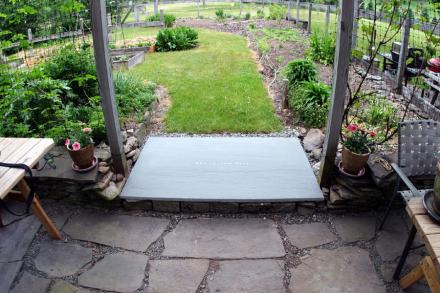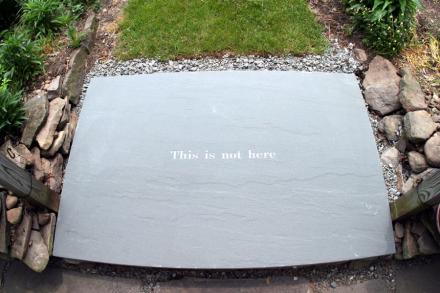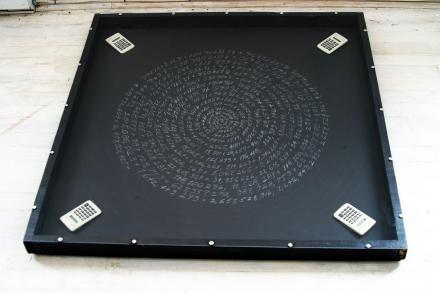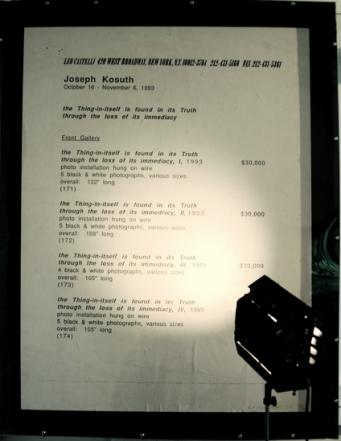
The process of picking up the threads of a project from 14 year ago, Faux Conceptual Art, is quite interesting. I’ve been framing the works, re-photographing them and creating new pieces. Looking at four works I see similar themes and ideas emerging. The pieces, Fibonacci Series With Calculators, Sit On, Price List and Not Here, have never been exhibited other than being presented on the web. This is a very strange idea. The whole web site, Faux Conceptual Art is a work that is a proposition. It is also in some measure a critique of the art market. Since re-engaging the works I am plodding along at a leisurely rate like a sort of anthropologist trying to piece together what I was thinking. This becomes fairly interesting because the world has changed, art discourse has advanced, and I have gone through many stages in that time.
 this is not here
this is not here
Along with that I’ve started to create new pieces. The latest is a stone piece called Not Here (2007). Sand blasted into the bluestone slab (64” x 32”) are the words, This Is Not Here. To my mind it is about the impulse to manifest an idea in a physical form. The words negate the physical aspect of the stone. You do something in stone because it is very much about being there and staying put. The stone is placed at the entrance to a garden. It can be read as a neo-platonic tautology. It functions as art and yet it has no place in the art market. Indeed, in the art market I would call this piece yet another stylistic variation of Faux Conceptual Art. Here then is the problem with the art market and it’s tendency to mediocrity. There are a few people who are wildly successful at the market. The majority of artists are not. They do in varying degrees engage the market. If the discourse is only about the market than it become necessary for an art that can critique the market and its mechanisms. This would be something akin to a Salon des Réfusés from an earlier epoch.
I could make the case that a neo-platonic tautology cannot be stylistic intellectual property even if I were to claim that it was a “fake” Lawrence Weiner. Interestingly enough, I recently showed this to an artist friend and she immediately said it reminded her of a Felix Gonzales-Torres piece. For me the inspiration might be more like the 1961 Piero Manzoni work, Socle du Monde (base of the world). Indeed, if anything I am extending and negating the information and logical systems of earlier conceptual art. This is quite different from a Post-Modernist position of style mixing. I tend to be more interested in the idea of détournement and especially mediated détournement.

An earlier piece Fibonacci Series with Calculators is actually a closed system in which the limitation is the calculators determine when the series is complete. This piece refers back to a 1961 Robert Morris work, Box With The Sound Of Its’ Own Making. In this case the “making” is the series of calculations within the Fibonacci series. The Fibonacci Series With Calculators is also somewhat of an open-ended work. It is radically different than any of Mario Merz’s earlier works that use the Fibonacci series. Indeed, Fibonacci Series With Calculators can be constructed at different scales depending on the memory and calculating power of the calculators used in the piece. I can envision a very large plaza with 4 computers, in kiosks at each corner. Starting at the center is the number series as calculated by those 4 computers, perhaps made of brass wire embedded in the actual plaza or this could be done in an art gallery in which the floor has been covered with blackboard paint, the Fibonacci series written on the floor spiraling out from the center. This is another clue to the art market, it’s whims and its raison d’etre. What is the potential for an artwork that really has no fixed form? Is this an artwork at all? In art market terms it’s not art. The reason is that is has never been set loose in the market. And yet we all know that this artwork exists. In a very odd way I have denied the art market just as it has denied me.
 Three-In-One
Three-In-One
The work, Sit-On, is the clearest example of détournement. It’s also a bit simplistic. The photo of a chair cannot be sat on, the words are cut out stencils that deny the handwork, and the sawed up and re-built chair is impossible to sit on.
I played with the signature piece by Joseph Kosuth, One and Three Chairs but the reality is that the Sit-On piece has little to do with Kosuth’s original premise.
Indeed, the piece has more to do with advertising billboards and has a sly reference to Gordon Matta-Clark and Arman, as well as Warhol, Rauschenberg, and Jasper Johns, not to mention Cubism, Futurism and Dynamism. This piece hangs in my living room over my couch. I made it to hang over a couch. It is the quintessential, “couch” piece. It invites one to sit on the couch.
 Price List
Price ListIn the manipulation of my works I’ve added new elements. For the Giant Kosuth Price List (1993 & 2007) I’ve added a theatrical klieg light. The piece now escalates the reference to the art market to a theatrical event. This makes it obvious that shopping as theater is part of the current art discourse. There’s also a punk position in al these works. They use cheap materials for the framing. The craftsmanship is not the high polish standards of neo-geo. They are hand made but not consciously expressive in the making. I’d call it Home Depot art. Even the stone piece is made with a less appealing stone that is bluestone rather than granite. Indeed, the monument is actually a fragile affair. It hasn’t yet gone through a winter. I am waiting to see if the incised letters will crack and flake from the freeze and thaw.
http://nujus.net/gh
http://www.artnetweb.com/projects/fauxcon/home.html